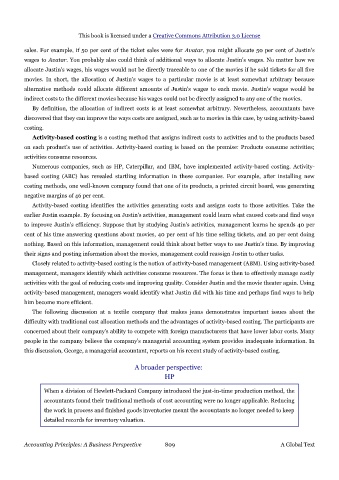Page 808 - Accounting Principles (A Business Perspective)
P. 808
This book is licensed under a Creative Commons Attribution 3.0 License
sales. For example, if 50 per cent of the ticket sales were for Avatar, you might allocate 50 per cent of Justin's
wages to Avatar. You probably also could think of additional ways to allocate Justin's wages. No matter how we
allocate Justin's wages, his wages would not be directly traceable to one of the movies if he sold tickets for all five
movies. In short, the allocation of Justin's wages to a particular movie is at least somewhat arbitrary because
alternative methods could allocate different amounts of Justin's wages to each movie. Justin's wages would be
indirect costs to the different movies because his wages could not be directly assigned to any one of the movies.
By definition, the allocation of indirect costs is at least somewhat arbitrary. Nevertheless, accountants have
discovered that they can improve the ways costs are assigned, such as to movies in this case, by using activity-based
costing.
Activity-based costing is a costing method that assigns indirect costs to activities and to the products based
on each product's use of activities. Activity-based costing is based on the premise: Products consume activities;
activities consume resources.
Numerous companies, such as HP, Caterpillar, and IBM, have implemented activity-based costing. Activity-
based costing (ABC) has revealed startling information in these companies. For example, after installing new
costing methods, one well-known company found that one of its products, a printed circuit board, was generating
negative margins of 46 per cent.
Activity-based costing identifies the activities generating costs and assigns costs to those activities. Take the
earlier Justin example. By focusing on Justin's activities, management could learn what caused costs and find ways
to improve Justin's efficiency. Suppose that by studying Justin's activities, management learns he spends 40 per
cent of his time answering questions about movies, 40 per cent of his time selling tickets, and 20 per cent doing
nothing. Based on this information, management could think about better ways to use Justin's time. By improving
their signs and posting information about the movies, management could reassign Justin to other tasks.
Closely related to activity-based costing is the notion of activity-based management (ABM). Using activity-based
management, managers identify which activities consume resources. The focus is then to effectively manage costly
activities with the goal of reducing costs and improving quality. Consider Justin and the movie theater again. Using
activity-based management, managers would identify what Justin did with his time and perhaps find ways to help
him become more efficient.
The following discussion at a textile company that makes jeans demonstrates important issues about the
difficulty with traditional cost allocation methods and the advantages of activity-based costing. The participants are
concerned about their company's ability to compete with foreign manufacturers that have lower labor costs. Many
people in the company believe the company's managerial accounting system provides inadequate information. In
this discussion, George, a managerial accountant, reports on his recent study of activity-based costing.
A broader perspective:
HP
When a division of Hewlett-Packard Company introduced the just-in-time production method, the
accountants found their traditional methods of cost accounting were no longer applicable. Reducing
the work in process and finished goods inventories meant the accountants no longer needed to keep
detailed records for inventory valuation.
Accounting Principles: A Business Perspective 809 A Global Text

